Consumer Behavior and Decision-Making in TESCO's Mobile Phone Launch
VerifiedAdded on 2021/02/19
|12
|3942
|21
Report
AI Summary
This report provides a comprehensive analysis of consumer behavior, focusing on the case of TESCO, a British multinational retail company. The report begins with an introduction to consumer behavior and its relevance to TESCO, followed by an in-depth examination of the consumer decision-making process, including the stages involved in purchasing goods and services, particularly in the context of TESCO launching a new mobile phone. The report then explores the importance of path mapping in understanding consumer journeys and how TESCO can identify customer needs to enhance sales. It further delves into the specific decision-making process for a product or service, outlining problem identification, information search, evaluation of alternatives, and post-purchase evaluation. Various consumer decision-making models, such as the cognitive, economic, and passive models, are discussed, highlighting their impact on consumer behavior. Finally, the report compares and contrasts B2B and B2C decision-making processes, providing a well-rounded understanding of consumer behavior and its implications for TESCO's marketing strategies and overall business operations.
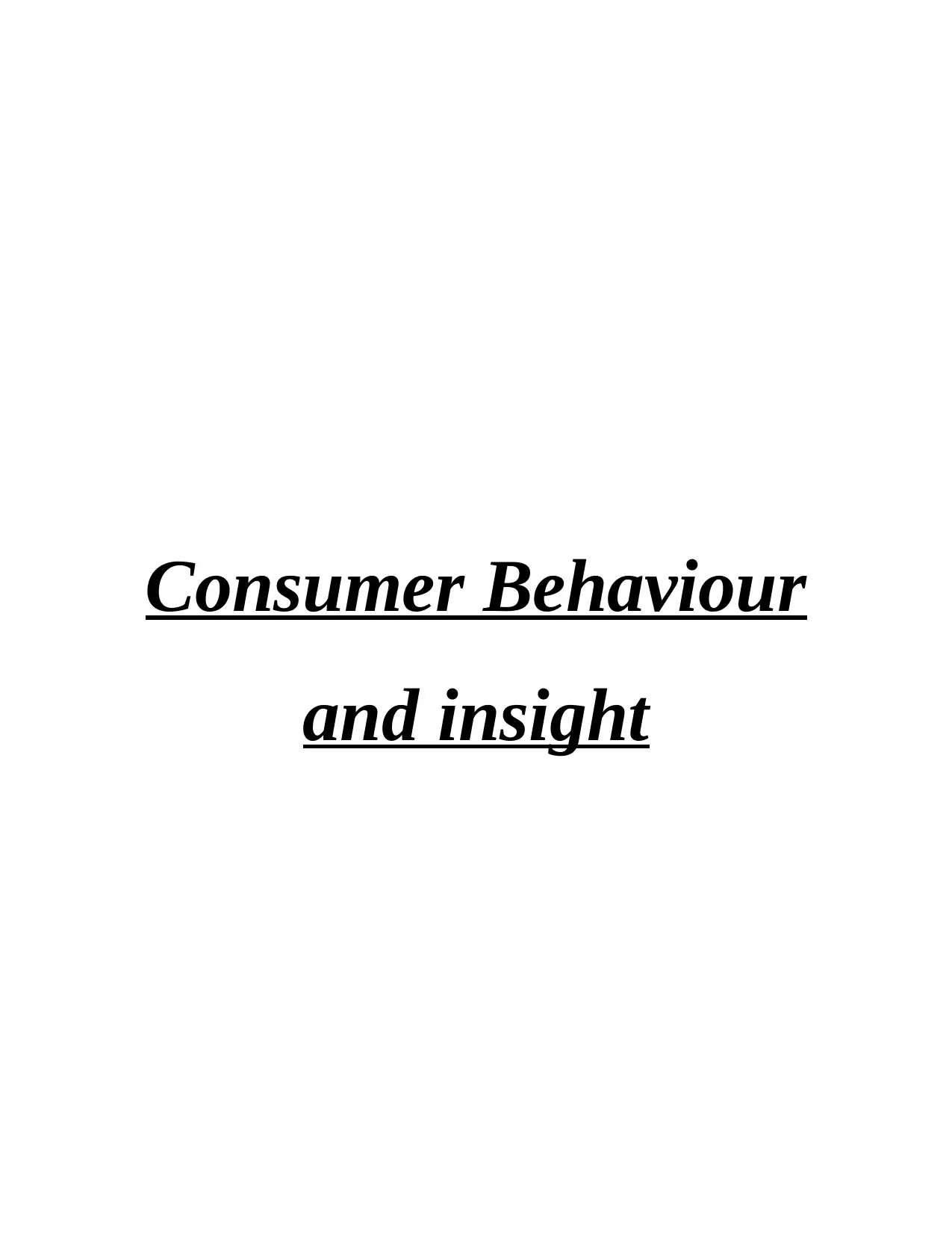
Consumer Behaviour
and insight
and insight
Paraphrase This Document
Need a fresh take? Get an instant paraphrase of this document with our AI Paraphraser
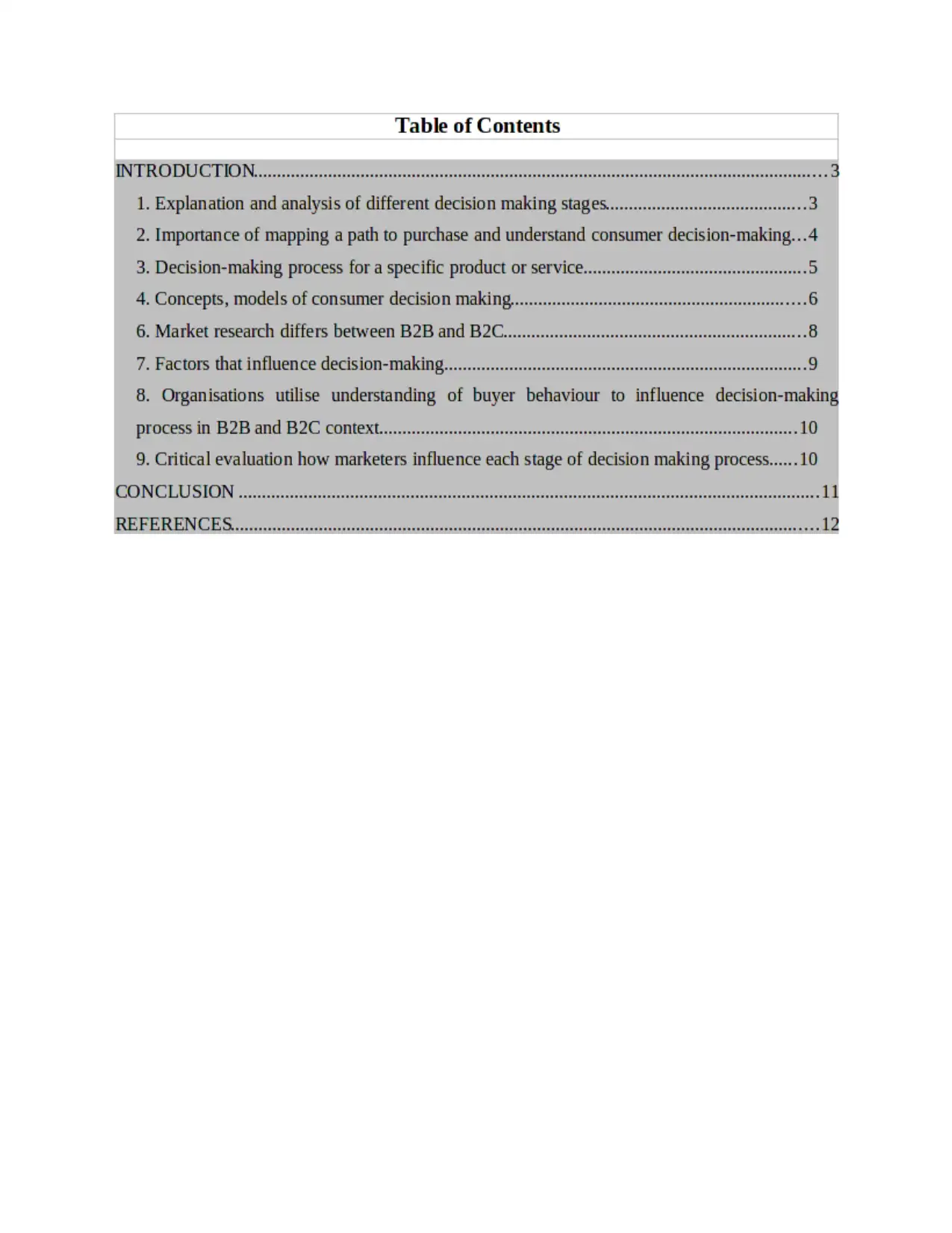
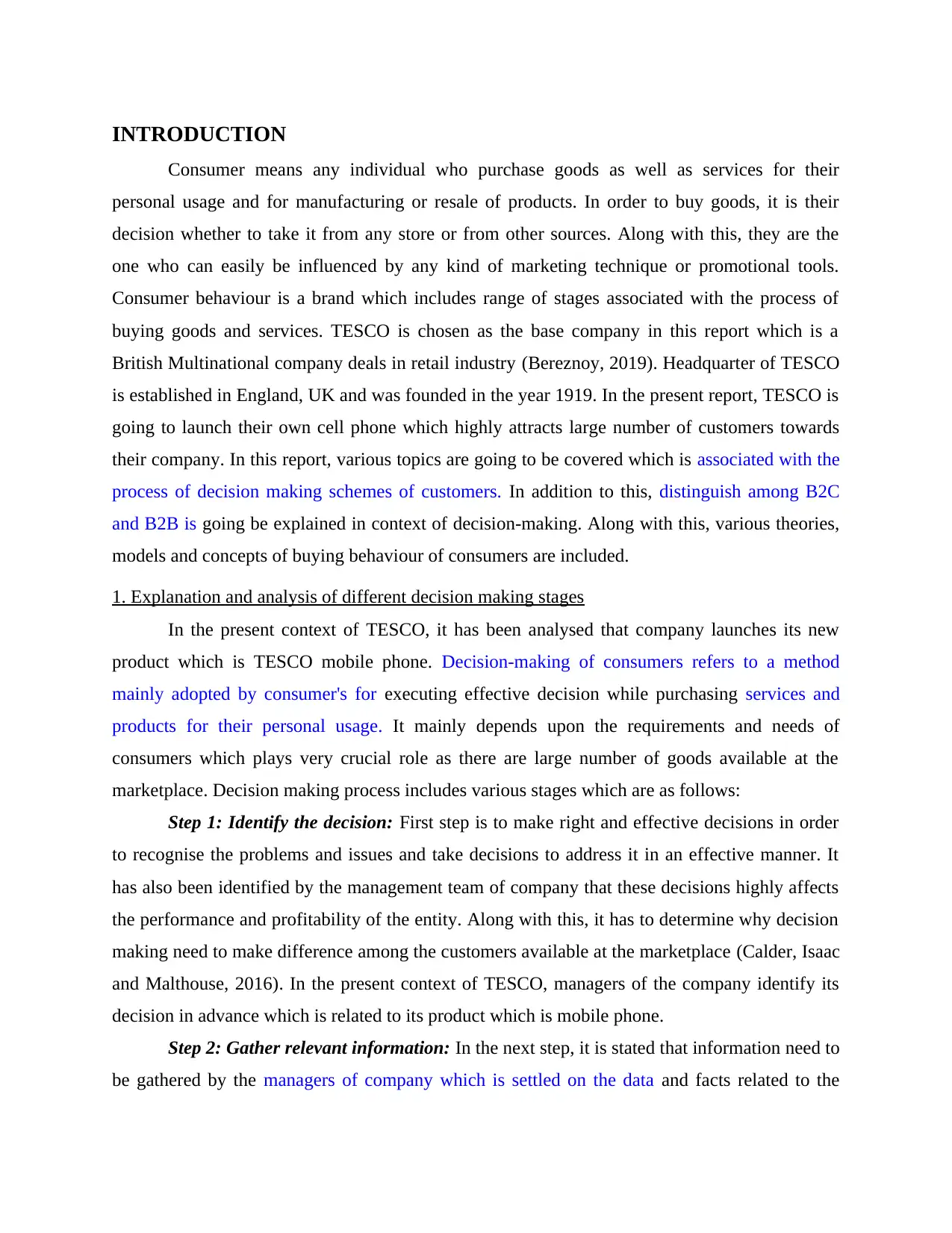
INTRODUCTION
Consumer means any individual who purchase goods as well as services for their
personal usage and for manufacturing or resale of products. In order to buy goods, it is their
decision whether to take it from any store or from other sources. Along with this, they are the
one who can easily be influenced by any kind of marketing technique or promotional tools.
Consumer behaviour is a brand which includes range of stages associated with the process of
buying goods and services. TESCO is chosen as the base company in this report which is a
British Multinational company deals in retail industry (Bereznoy, 2019). Headquarter of TESCO
is established in England, UK and was founded in the year 1919. In the present report, TESCO is
going to launch their own cell phone which highly attracts large number of customers towards
their company. In this report, various topics are going to be covered which is associated with the
process of decision making schemes of customers. In addition to this, distinguish among B2C
and B2B is going be explained in context of decision-making. Along with this, various theories,
models and concepts of buying behaviour of consumers are included.
1. Explanation and analysis of different decision making stages
In the present context of TESCO, it has been analysed that company launches its new
product which is TESCO mobile phone. Decision-making of consumers refers to a method
mainly adopted by consumer's for executing effective decision while purchasing services and
products for their personal usage. It mainly depends upon the requirements and needs of
consumers which plays very crucial role as there are large number of goods available at the
marketplace. Decision making process includes various stages which are as follows:
Step 1: Identify the decision: First step is to make right and effective decisions in order
to recognise the problems and issues and take decisions to address it in an effective manner. It
has also been identified by the management team of company that these decisions highly affects
the performance and profitability of the entity. Along with this, it has to determine why decision
making need to make difference among the customers available at the marketplace (Calder, Isaac
and Malthouse, 2016). In the present context of TESCO, managers of the company identify its
decision in advance which is related to its product which is mobile phone.
Step 2: Gather relevant information: In the next step, it is stated that information need to
be gathered by the managers of company which is settled on the data and facts related to the
Consumer means any individual who purchase goods as well as services for their
personal usage and for manufacturing or resale of products. In order to buy goods, it is their
decision whether to take it from any store or from other sources. Along with this, they are the
one who can easily be influenced by any kind of marketing technique or promotional tools.
Consumer behaviour is a brand which includes range of stages associated with the process of
buying goods and services. TESCO is chosen as the base company in this report which is a
British Multinational company deals in retail industry (Bereznoy, 2019). Headquarter of TESCO
is established in England, UK and was founded in the year 1919. In the present report, TESCO is
going to launch their own cell phone which highly attracts large number of customers towards
their company. In this report, various topics are going to be covered which is associated with the
process of decision making schemes of customers. In addition to this, distinguish among B2C
and B2B is going be explained in context of decision-making. Along with this, various theories,
models and concepts of buying behaviour of consumers are included.
1. Explanation and analysis of different decision making stages
In the present context of TESCO, it has been analysed that company launches its new
product which is TESCO mobile phone. Decision-making of consumers refers to a method
mainly adopted by consumer's for executing effective decision while purchasing services and
products for their personal usage. It mainly depends upon the requirements and needs of
consumers which plays very crucial role as there are large number of goods available at the
marketplace. Decision making process includes various stages which are as follows:
Step 1: Identify the decision: First step is to make right and effective decisions in order
to recognise the problems and issues and take decisions to address it in an effective manner. It
has also been identified by the management team of company that these decisions highly affects
the performance and profitability of the entity. Along with this, it has to determine why decision
making need to make difference among the customers available at the marketplace (Calder, Isaac
and Malthouse, 2016). In the present context of TESCO, managers of the company identify its
decision in advance which is related to its product which is mobile phone.
Step 2: Gather relevant information: In the next step, it is stated that information need to
be gathered by the managers of company which is settled on the data and facts related to the
⊘ This is a preview!⊘
Do you want full access?
Subscribe today to unlock all pages.

Trusted by 1+ million students worldwide
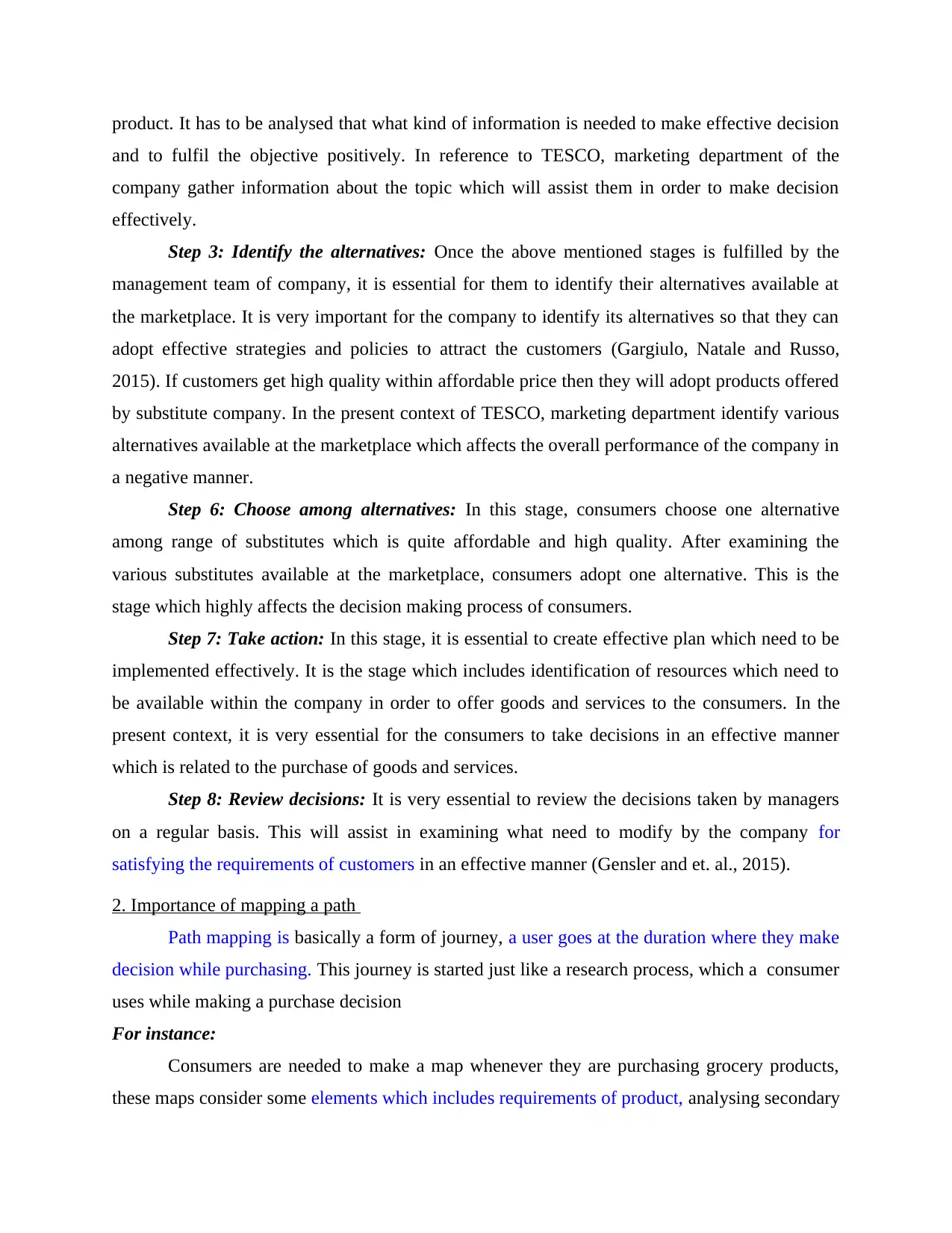
product. It has to be analysed that what kind of information is needed to make effective decision
and to fulfil the objective positively. In reference to TESCO, marketing department of the
company gather information about the topic which will assist them in order to make decision
effectively.
Step 3: Identify the alternatives: Once the above mentioned stages is fulfilled by the
management team of company, it is essential for them to identify their alternatives available at
the marketplace. It is very important for the company to identify its alternatives so that they can
adopt effective strategies and policies to attract the customers (Gargiulo, Natale and Russo,
2015). If customers get high quality within affordable price then they will adopt products offered
by substitute company. In the present context of TESCO, marketing department identify various
alternatives available at the marketplace which affects the overall performance of the company in
a negative manner.
Step 6: Choose among alternatives: In this stage, consumers choose one alternative
among range of substitutes which is quite affordable and high quality. After examining the
various substitutes available at the marketplace, consumers adopt one alternative. This is the
stage which highly affects the decision making process of consumers.
Step 7: Take action: In this stage, it is essential to create effective plan which need to be
implemented effectively. It is the stage which includes identification of resources which need to
be available within the company in order to offer goods and services to the consumers. In the
present context, it is very essential for the consumers to take decisions in an effective manner
which is related to the purchase of goods and services.
Step 8: Review decisions: It is very essential to review the decisions taken by managers
on a regular basis. This will assist in examining what need to modify by the company for
satisfying the requirements of customers in an effective manner (Gensler and et. al., 2015).
2. Importance of mapping a path
Path mapping is basically a form of journey, a user goes at the duration where they make
decision while purchasing. This journey is started just like a research process, which a consumer
uses while making a purchase decision
For instance:
Consumers are needed to make a map whenever they are purchasing grocery products,
these maps consider some elements which includes requirements of product, analysing secondary
and to fulfil the objective positively. In reference to TESCO, marketing department of the
company gather information about the topic which will assist them in order to make decision
effectively.
Step 3: Identify the alternatives: Once the above mentioned stages is fulfilled by the
management team of company, it is essential for them to identify their alternatives available at
the marketplace. It is very important for the company to identify its alternatives so that they can
adopt effective strategies and policies to attract the customers (Gargiulo, Natale and Russo,
2015). If customers get high quality within affordable price then they will adopt products offered
by substitute company. In the present context of TESCO, marketing department identify various
alternatives available at the marketplace which affects the overall performance of the company in
a negative manner.
Step 6: Choose among alternatives: In this stage, consumers choose one alternative
among range of substitutes which is quite affordable and high quality. After examining the
various substitutes available at the marketplace, consumers adopt one alternative. This is the
stage which highly affects the decision making process of consumers.
Step 7: Take action: In this stage, it is essential to create effective plan which need to be
implemented effectively. It is the stage which includes identification of resources which need to
be available within the company in order to offer goods and services to the consumers. In the
present context, it is very essential for the consumers to take decisions in an effective manner
which is related to the purchase of goods and services.
Step 8: Review decisions: It is very essential to review the decisions taken by managers
on a regular basis. This will assist in examining what need to modify by the company for
satisfying the requirements of customers in an effective manner (Gensler and et. al., 2015).
2. Importance of mapping a path
Path mapping is basically a form of journey, a user goes at the duration where they make
decision while purchasing. This journey is started just like a research process, which a consumer
uses while making a purchase decision
For instance:
Consumers are needed to make a map whenever they are purchasing grocery products,
these maps consider some elements which includes requirements of product, analysing secondary
Paraphrase This Document
Need a fresh take? Get an instant paraphrase of this document with our AI Paraphraser
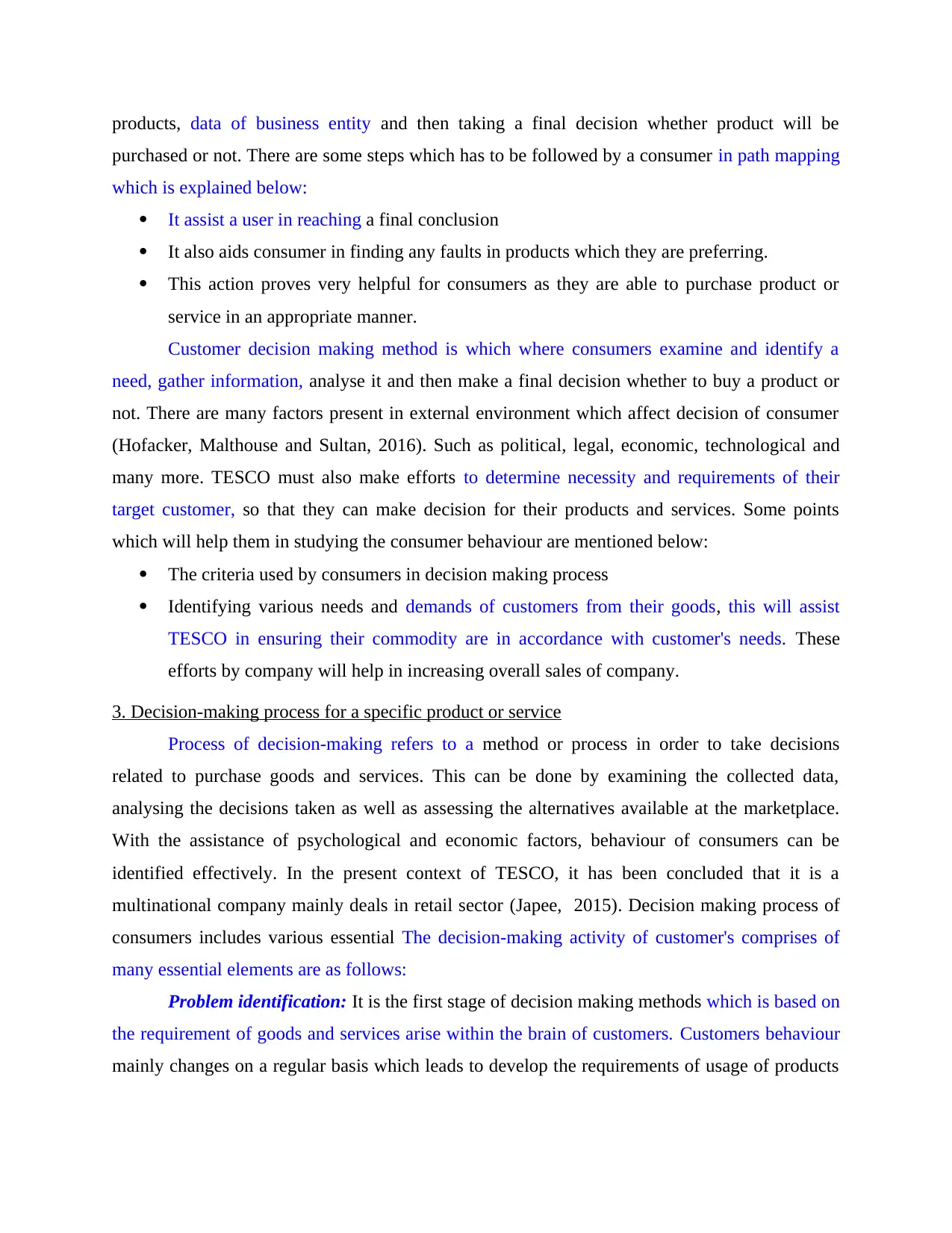
products, data of business entity and then taking a final decision whether product will be
purchased or not. There are some steps which has to be followed by a consumer in path mapping
which is explained below:
It assist a user in reaching a final conclusion
It also aids consumer in finding any faults in products which they are preferring.
This action proves very helpful for consumers as they are able to purchase product or
service in an appropriate manner.
Customer decision making method is which where consumers examine and identify a
need, gather information, analyse it and then make a final decision whether to buy a product or
not. There are many factors present in external environment which affect decision of consumer
(Hofacker, Malthouse and Sultan, 2016). Such as political, legal, economic, technological and
many more. TESCO must also make efforts to determine necessity and requirements of their
target customer, so that they can make decision for their products and services. Some points
which will help them in studying the consumer behaviour are mentioned below:
The criteria used by consumers in decision making process
Identifying various needs and demands of customers from their goods, this will assist
TESCO in ensuring their commodity are in accordance with customer's needs. These
efforts by company will help in increasing overall sales of company.
3. Decision-making process for a specific product or service
Process of decision-making refers to a method or process in order to take decisions
related to purchase goods and services. This can be done by examining the collected data,
analysing the decisions taken as well as assessing the alternatives available at the marketplace.
With the assistance of psychological and economic factors, behaviour of consumers can be
identified effectively. In the present context of TESCO, it has been concluded that it is a
multinational company mainly deals in retail sector (Japee, 2015). Decision making process of
consumers includes various essential The decision-making activity of customer's comprises of
many essential elements are as follows:
Problem identification: It is the first stage of decision making methods which is based on
the requirement of goods and services arise within the brain of customers. Customers behaviour
mainly changes on a regular basis which leads to develop the requirements of usage of products
purchased or not. There are some steps which has to be followed by a consumer in path mapping
which is explained below:
It assist a user in reaching a final conclusion
It also aids consumer in finding any faults in products which they are preferring.
This action proves very helpful for consumers as they are able to purchase product or
service in an appropriate manner.
Customer decision making method is which where consumers examine and identify a
need, gather information, analyse it and then make a final decision whether to buy a product or
not. There are many factors present in external environment which affect decision of consumer
(Hofacker, Malthouse and Sultan, 2016). Such as political, legal, economic, technological and
many more. TESCO must also make efforts to determine necessity and requirements of their
target customer, so that they can make decision for their products and services. Some points
which will help them in studying the consumer behaviour are mentioned below:
The criteria used by consumers in decision making process
Identifying various needs and demands of customers from their goods, this will assist
TESCO in ensuring their commodity are in accordance with customer's needs. These
efforts by company will help in increasing overall sales of company.
3. Decision-making process for a specific product or service
Process of decision-making refers to a method or process in order to take decisions
related to purchase goods and services. This can be done by examining the collected data,
analysing the decisions taken as well as assessing the alternatives available at the marketplace.
With the assistance of psychological and economic factors, behaviour of consumers can be
identified effectively. In the present context of TESCO, it has been concluded that it is a
multinational company mainly deals in retail sector (Japee, 2015). Decision making process of
consumers includes various essential The decision-making activity of customer's comprises of
many essential elements are as follows:
Problem identification: It is the first stage of decision making methods which is based on
the requirement of goods and services arise within the brain of customers. Customers behaviour
mainly changes on a regular basis which leads to develop the requirements of usage of products
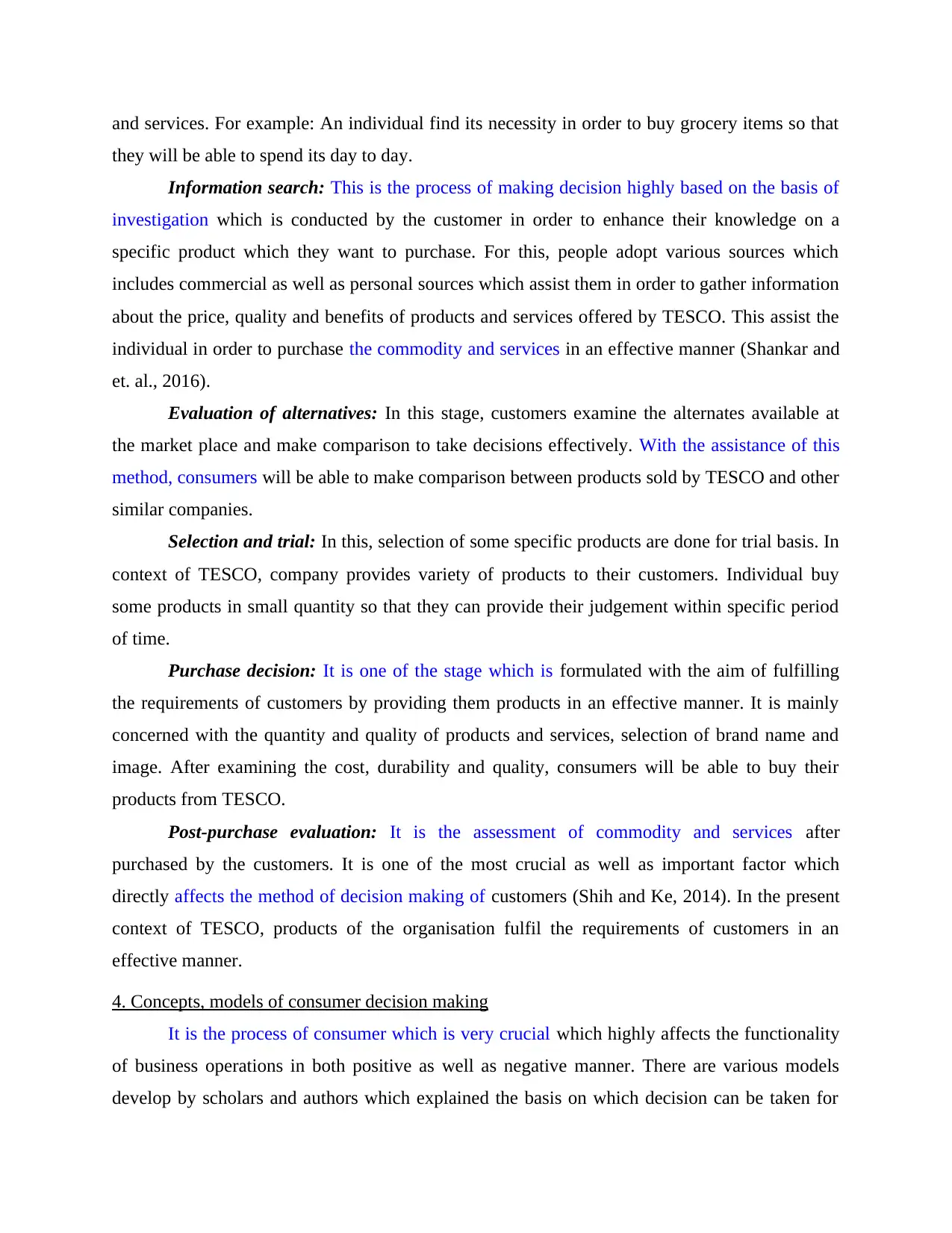
and services. For example: An individual find its necessity in order to buy grocery items so that
they will be able to spend its day to day.
Information search: This is the process of making decision highly based on the basis of
investigation which is conducted by the customer in order to enhance their knowledge on a
specific product which they want to purchase. For this, people adopt various sources which
includes commercial as well as personal sources which assist them in order to gather information
about the price, quality and benefits of products and services offered by TESCO. This assist the
individual in order to purchase the commodity and services in an effective manner (Shankar and
et. al., 2016).
Evaluation of alternatives: In this stage, customers examine the alternates available at
the market place and make comparison to take decisions effectively. With the assistance of this
method, consumers will be able to make comparison between products sold by TESCO and other
similar companies.
Selection and trial: In this, selection of some specific products are done for trial basis. In
context of TESCO, company provides variety of products to their customers. Individual buy
some products in small quantity so that they can provide their judgement within specific period
of time.
Purchase decision: It is one of the stage which is formulated with the aim of fulfilling
the requirements of customers by providing them products in an effective manner. It is mainly
concerned with the quantity and quality of products and services, selection of brand name and
image. After examining the cost, durability and quality, consumers will be able to buy their
products from TESCO.
Post-purchase evaluation: It is the assessment of commodity and services after
purchased by the customers. It is one of the most crucial as well as important factor which
directly affects the method of decision making of customers (Shih and Ke, 2014). In the present
context of TESCO, products of the organisation fulfil the requirements of customers in an
effective manner.
4. Concepts, models of consumer decision making
It is the process of consumer which is very crucial which highly affects the functionality
of business operations in both positive as well as negative manner. There are various models
develop by scholars and authors which explained the basis on which decision can be taken for
they will be able to spend its day to day.
Information search: This is the process of making decision highly based on the basis of
investigation which is conducted by the customer in order to enhance their knowledge on a
specific product which they want to purchase. For this, people adopt various sources which
includes commercial as well as personal sources which assist them in order to gather information
about the price, quality and benefits of products and services offered by TESCO. This assist the
individual in order to purchase the commodity and services in an effective manner (Shankar and
et. al., 2016).
Evaluation of alternatives: In this stage, customers examine the alternates available at
the market place and make comparison to take decisions effectively. With the assistance of this
method, consumers will be able to make comparison between products sold by TESCO and other
similar companies.
Selection and trial: In this, selection of some specific products are done for trial basis. In
context of TESCO, company provides variety of products to their customers. Individual buy
some products in small quantity so that they can provide their judgement within specific period
of time.
Purchase decision: It is one of the stage which is formulated with the aim of fulfilling
the requirements of customers by providing them products in an effective manner. It is mainly
concerned with the quantity and quality of products and services, selection of brand name and
image. After examining the cost, durability and quality, consumers will be able to buy their
products from TESCO.
Post-purchase evaluation: It is the assessment of commodity and services after
purchased by the customers. It is one of the most crucial as well as important factor which
directly affects the method of decision making of customers (Shih and Ke, 2014). In the present
context of TESCO, products of the organisation fulfil the requirements of customers in an
effective manner.
4. Concepts, models of consumer decision making
It is the process of consumer which is very crucial which highly affects the functionality
of business operations in both positive as well as negative manner. There are various models
develop by scholars and authors which explained the basis on which decision can be taken for
⊘ This is a preview!⊘
Do you want full access?
Subscribe today to unlock all pages.

Trusted by 1+ million students worldwide
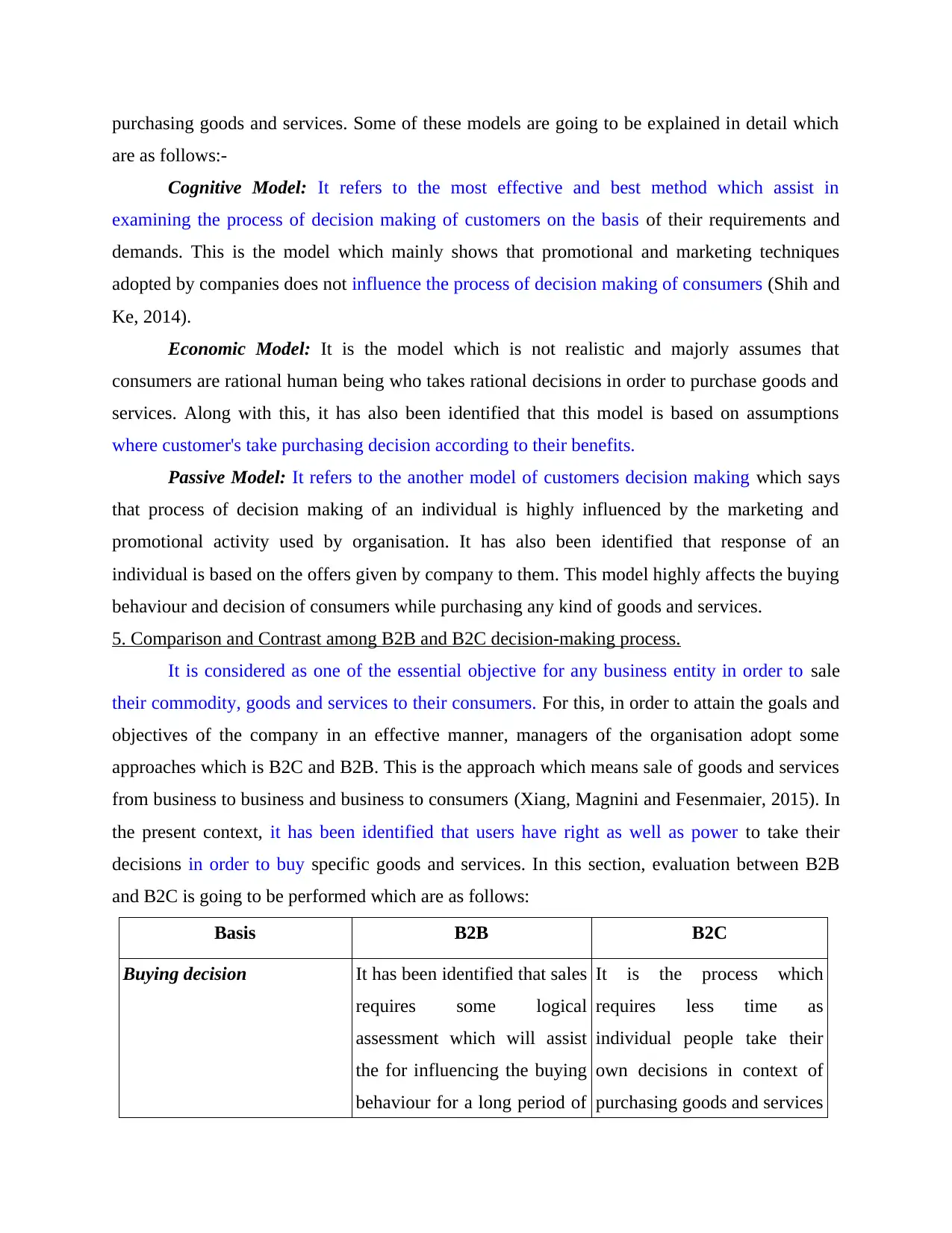
purchasing goods and services. Some of these models are going to be explained in detail which
are as follows:-
Cognitive Model: It refers to the most effective and best method which assist in
examining the process of decision making of customers on the basis of their requirements and
demands. This is the model which mainly shows that promotional and marketing techniques
adopted by companies does not influence the process of decision making of consumers (Shih and
Ke, 2014).
Economic Model: It is the model which is not realistic and majorly assumes that
consumers are rational human being who takes rational decisions in order to purchase goods and
services. Along with this, it has also been identified that this model is based on assumptions
where customer's take purchasing decision according to their benefits.
Passive Model: It refers to the another model of customers decision making which says
that process of decision making of an individual is highly influenced by the marketing and
promotional activity used by organisation. It has also been identified that response of an
individual is based on the offers given by company to them. This model highly affects the buying
behaviour and decision of consumers while purchasing any kind of goods and services.
5. Comparison and Contrast among B2B and B2C decision-making process.
It is considered as one of the essential objective for any business entity in order to sale
their commodity, goods and services to their consumers. For this, in order to attain the goals and
objectives of the company in an effective manner, managers of the organisation adopt some
approaches which is B2C and B2B. This is the approach which means sale of goods and services
from business to business and business to consumers (Xiang, Magnini and Fesenmaier, 2015). In
the present context, it has been identified that users have right as well as power to take their
decisions in order to buy specific goods and services. In this section, evaluation between B2B
and B2C is going to be performed which are as follows:
Basis B2B B2C
Buying decision It has been identified that sales
requires some logical
assessment which will assist
the for influencing the buying
behaviour for a long period of
It is the process which
requires less time as
individual people take their
own decisions in context of
purchasing goods and services
are as follows:-
Cognitive Model: It refers to the most effective and best method which assist in
examining the process of decision making of customers on the basis of their requirements and
demands. This is the model which mainly shows that promotional and marketing techniques
adopted by companies does not influence the process of decision making of consumers (Shih and
Ke, 2014).
Economic Model: It is the model which is not realistic and majorly assumes that
consumers are rational human being who takes rational decisions in order to purchase goods and
services. Along with this, it has also been identified that this model is based on assumptions
where customer's take purchasing decision according to their benefits.
Passive Model: It refers to the another model of customers decision making which says
that process of decision making of an individual is highly influenced by the marketing and
promotional activity used by organisation. It has also been identified that response of an
individual is based on the offers given by company to them. This model highly affects the buying
behaviour and decision of consumers while purchasing any kind of goods and services.
5. Comparison and Contrast among B2B and B2C decision-making process.
It is considered as one of the essential objective for any business entity in order to sale
their commodity, goods and services to their consumers. For this, in order to attain the goals and
objectives of the company in an effective manner, managers of the organisation adopt some
approaches which is B2C and B2B. This is the approach which means sale of goods and services
from business to business and business to consumers (Xiang, Magnini and Fesenmaier, 2015). In
the present context, it has been identified that users have right as well as power to take their
decisions in order to buy specific goods and services. In this section, evaluation between B2B
and B2C is going to be performed which are as follows:
Basis B2B B2C
Buying decision It has been identified that sales
requires some logical
assessment which will assist
the for influencing the buying
behaviour for a long period of
It is the process which
requires less time as
individual people take their
own decisions in context of
purchasing goods and services
Paraphrase This Document
Need a fresh take? Get an instant paraphrase of this document with our AI Paraphraser
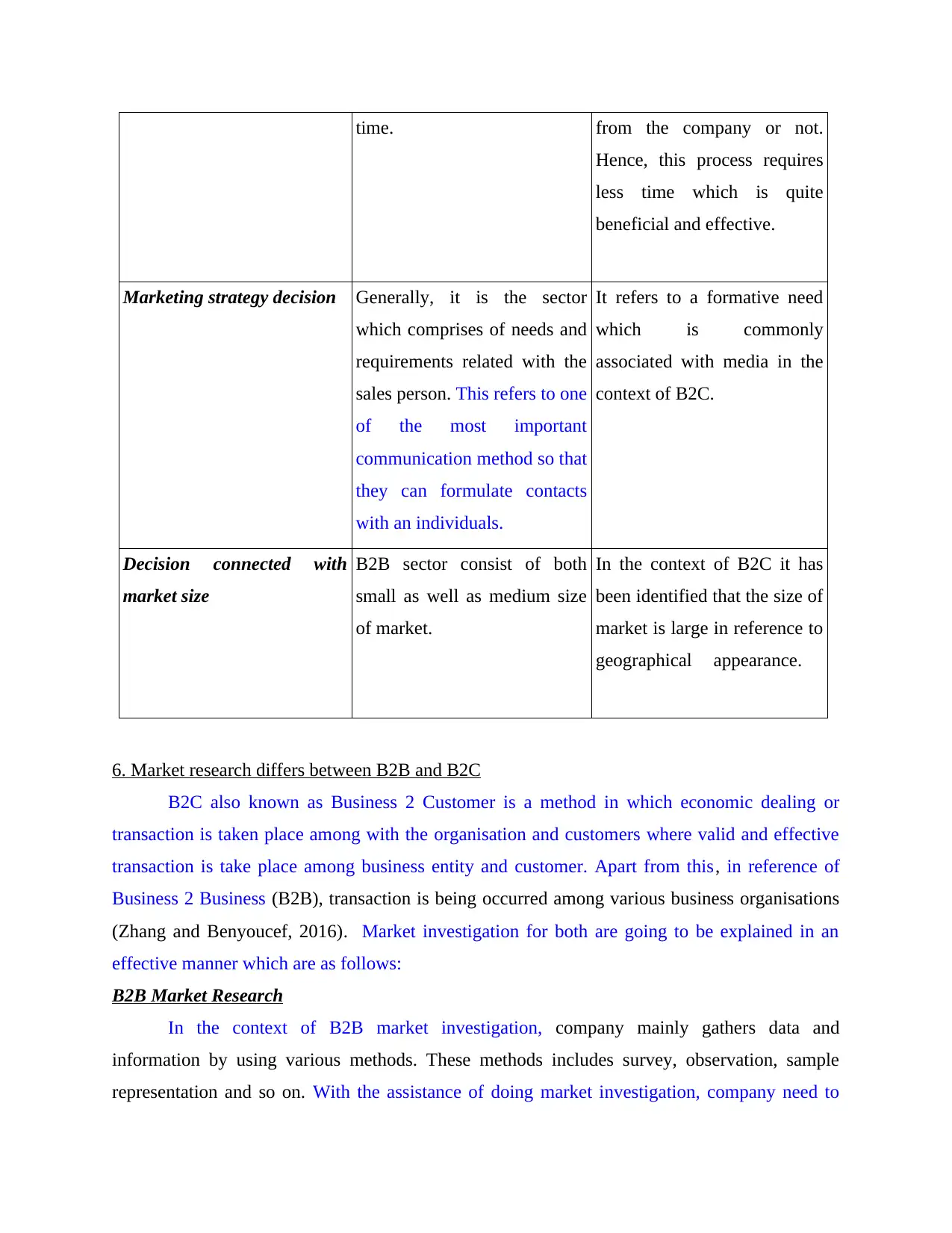
time. from the company or not.
Hence, this process requires
less time which is quite
beneficial and effective.
Marketing strategy decision Generally, it is the sector
which comprises of needs and
requirements related with the
sales person. This refers to one
of the most important
communication method so that
they can formulate contacts
with an individuals.
It refers to a formative need
which is commonly
associated with media in the
context of B2C.
Decision connected with
market size
B2B sector consist of both
small as well as medium size
of market.
In the context of B2C it has
been identified that the size of
market is large in reference to
geographical appearance.
6. Market research differs between B2B and B2C
B2C also known as Business 2 Customer is a method in which economic dealing or
transaction is taken place among with the organisation and customers where valid and effective
transaction is take place among business entity and customer. Apart from this, in reference of
Business 2 Business (B2B), transaction is being occurred among various business organisations
(Zhang and Benyoucef, 2016). Market investigation for both are going to be explained in an
effective manner which are as follows:
B2B Market Research
In the context of B2B market investigation, company mainly gathers data and
information by using various methods. These methods includes survey, observation, sample
representation and so on. With the assistance of doing market investigation, company need to
Hence, this process requires
less time which is quite
beneficial and effective.
Marketing strategy decision Generally, it is the sector
which comprises of needs and
requirements related with the
sales person. This refers to one
of the most important
communication method so that
they can formulate contacts
with an individuals.
It refers to a formative need
which is commonly
associated with media in the
context of B2C.
Decision connected with
market size
B2B sector consist of both
small as well as medium size
of market.
In the context of B2C it has
been identified that the size of
market is large in reference to
geographical appearance.
6. Market research differs between B2B and B2C
B2C also known as Business 2 Customer is a method in which economic dealing or
transaction is taken place among with the organisation and customers where valid and effective
transaction is take place among business entity and customer. Apart from this, in reference of
Business 2 Business (B2B), transaction is being occurred among various business organisations
(Zhang and Benyoucef, 2016). Market investigation for both are going to be explained in an
effective manner which are as follows:
B2B Market Research
In the context of B2B market investigation, company mainly gathers data and
information by using various methods. These methods includes survey, observation, sample
representation and so on. With the assistance of doing market investigation, company need to
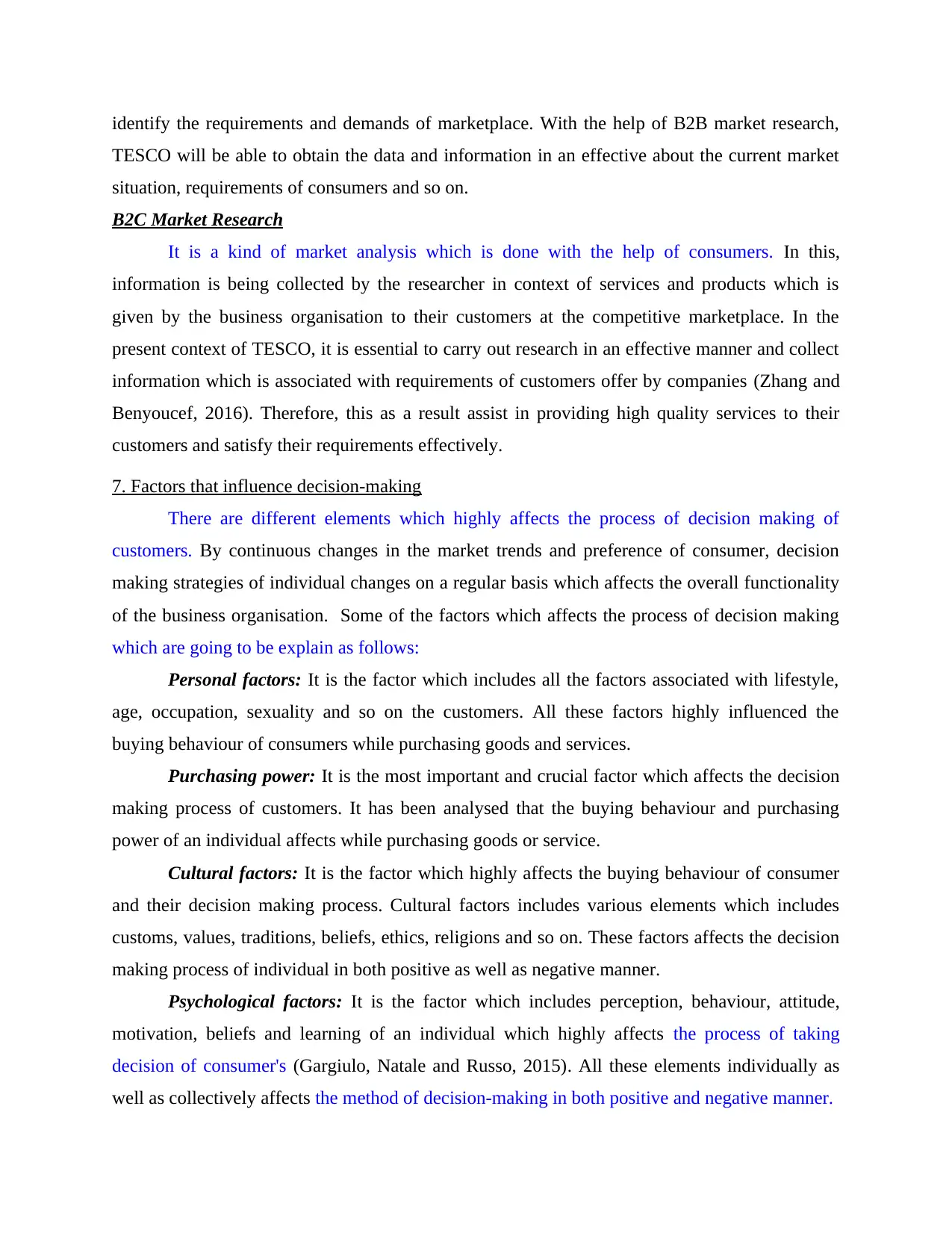
identify the requirements and demands of marketplace. With the help of B2B market research,
TESCO will be able to obtain the data and information in an effective about the current market
situation, requirements of consumers and so on.
B2C Market Research
It is a kind of market analysis which is done with the help of consumers. In this,
information is being collected by the researcher in context of services and products which is
given by the business organisation to their customers at the competitive marketplace. In the
present context of TESCO, it is essential to carry out research in an effective manner and collect
information which is associated with requirements of customers offer by companies (Zhang and
Benyoucef, 2016). Therefore, this as a result assist in providing high quality services to their
customers and satisfy their requirements effectively.
7. Factors that influence decision-making
There are different elements which highly affects the process of decision making of
customers. By continuous changes in the market trends and preference of consumer, decision
making strategies of individual changes on a regular basis which affects the overall functionality
of the business organisation. Some of the factors which affects the process of decision making
which are going to be explain as follows:
Personal factors: It is the factor which includes all the factors associated with lifestyle,
age, occupation, sexuality and so on the customers. All these factors highly influenced the
buying behaviour of consumers while purchasing goods and services.
Purchasing power: It is the most important and crucial factor which affects the decision
making process of customers. It has been analysed that the buying behaviour and purchasing
power of an individual affects while purchasing goods or service.
Cultural factors: It is the factor which highly affects the buying behaviour of consumer
and their decision making process. Cultural factors includes various elements which includes
customs, values, traditions, beliefs, ethics, religions and so on. These factors affects the decision
making process of individual in both positive as well as negative manner.
Psychological factors: It is the factor which includes perception, behaviour, attitude,
motivation, beliefs and learning of an individual which highly affects the process of taking
decision of consumer's (Gargiulo, Natale and Russo, 2015). All these elements individually as
well as collectively affects the method of decision-making in both positive and negative manner.
TESCO will be able to obtain the data and information in an effective about the current market
situation, requirements of consumers and so on.
B2C Market Research
It is a kind of market analysis which is done with the help of consumers. In this,
information is being collected by the researcher in context of services and products which is
given by the business organisation to their customers at the competitive marketplace. In the
present context of TESCO, it is essential to carry out research in an effective manner and collect
information which is associated with requirements of customers offer by companies (Zhang and
Benyoucef, 2016). Therefore, this as a result assist in providing high quality services to their
customers and satisfy their requirements effectively.
7. Factors that influence decision-making
There are different elements which highly affects the process of decision making of
customers. By continuous changes in the market trends and preference of consumer, decision
making strategies of individual changes on a regular basis which affects the overall functionality
of the business organisation. Some of the factors which affects the process of decision making
which are going to be explain as follows:
Personal factors: It is the factor which includes all the factors associated with lifestyle,
age, occupation, sexuality and so on the customers. All these factors highly influenced the
buying behaviour of consumers while purchasing goods and services.
Purchasing power: It is the most important and crucial factor which affects the decision
making process of customers. It has been analysed that the buying behaviour and purchasing
power of an individual affects while purchasing goods or service.
Cultural factors: It is the factor which highly affects the buying behaviour of consumer
and their decision making process. Cultural factors includes various elements which includes
customs, values, traditions, beliefs, ethics, religions and so on. These factors affects the decision
making process of individual in both positive as well as negative manner.
Psychological factors: It is the factor which includes perception, behaviour, attitude,
motivation, beliefs and learning of an individual which highly affects the process of taking
decision of consumer's (Gargiulo, Natale and Russo, 2015). All these elements individually as
well as collectively affects the method of decision-making in both positive and negative manner.
⊘ This is a preview!⊘
Do you want full access?
Subscribe today to unlock all pages.

Trusted by 1+ million students worldwide
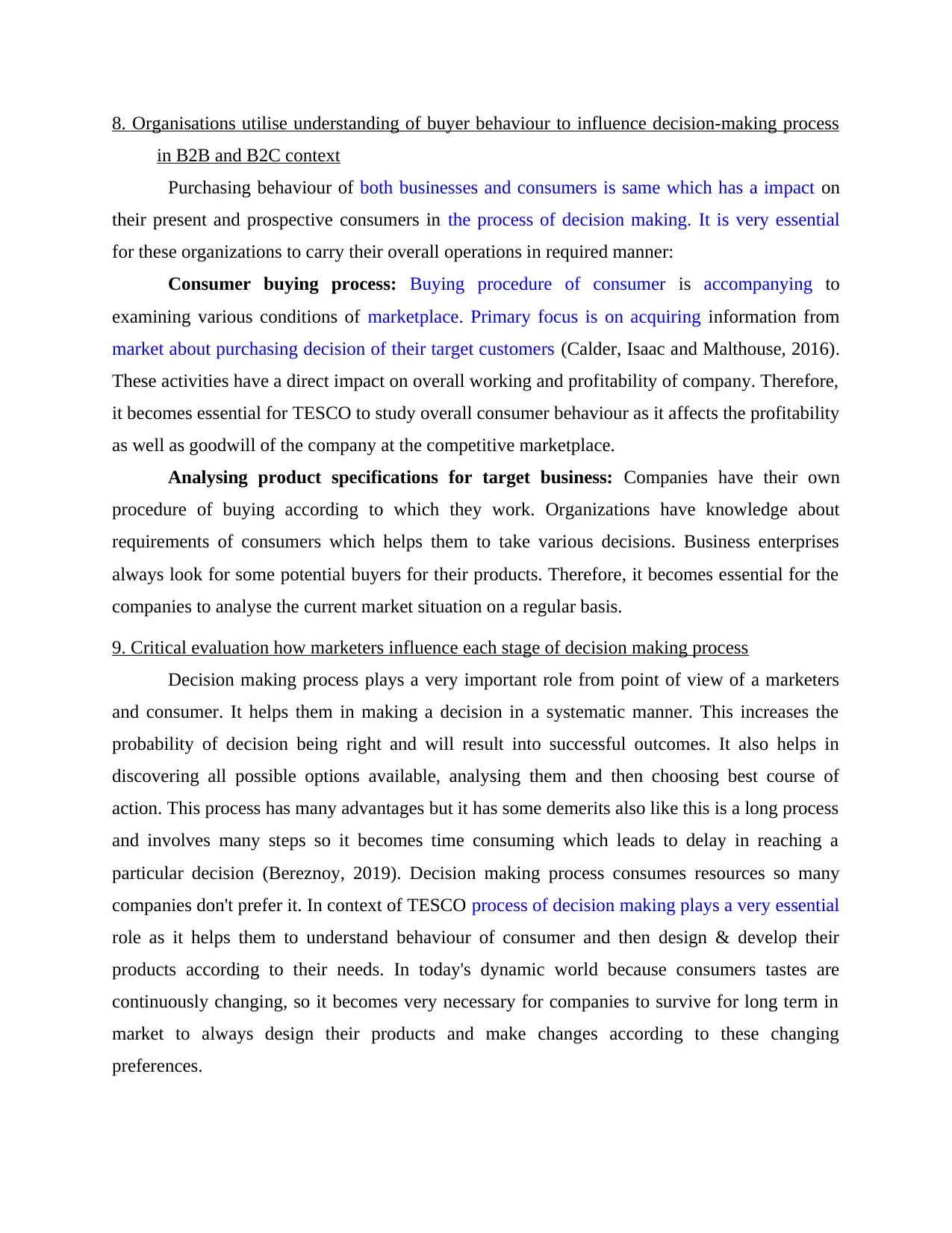
8. Organisations utilise understanding of buyer behaviour to influence decision-making process
in B2B and B2C context
Purchasing behaviour of both businesses and consumers is same which has a impact on
their present and prospective consumers in the process of decision making. It is very essential
for these organizations to carry their overall operations in required manner:
Consumer buying process: Buying procedure of consumer is accompanying to
examining various conditions of marketplace. Primary focus is on acquiring information from
market about purchasing decision of their target customers (Calder, Isaac and Malthouse, 2016).
These activities have a direct impact on overall working and profitability of company. Therefore,
it becomes essential for TESCO to study overall consumer behaviour as it affects the profitability
as well as goodwill of the company at the competitive marketplace.
Analysing product specifications for target business: Companies have their own
procedure of buying according to which they work. Organizations have knowledge about
requirements of consumers which helps them to take various decisions. Business enterprises
always look for some potential buyers for their products. Therefore, it becomes essential for the
companies to analyse the current market situation on a regular basis.
9. Critical evaluation how marketers influence each stage of decision making process
Decision making process plays a very important role from point of view of a marketers
and consumer. It helps them in making a decision in a systematic manner. This increases the
probability of decision being right and will result into successful outcomes. It also helps in
discovering all possible options available, analysing them and then choosing best course of
action. This process has many advantages but it has some demerits also like this is a long process
and involves many steps so it becomes time consuming which leads to delay in reaching a
particular decision (Bereznoy, 2019). Decision making process consumes resources so many
companies don't prefer it. In context of TESCO process of decision making plays a very essential
role as it helps them to understand behaviour of consumer and then design & develop their
products according to their needs. In today's dynamic world because consumers tastes are
continuously changing, so it becomes very necessary for companies to survive for long term in
market to always design their products and make changes according to these changing
preferences.
in B2B and B2C context
Purchasing behaviour of both businesses and consumers is same which has a impact on
their present and prospective consumers in the process of decision making. It is very essential
for these organizations to carry their overall operations in required manner:
Consumer buying process: Buying procedure of consumer is accompanying to
examining various conditions of marketplace. Primary focus is on acquiring information from
market about purchasing decision of their target customers (Calder, Isaac and Malthouse, 2016).
These activities have a direct impact on overall working and profitability of company. Therefore,
it becomes essential for TESCO to study overall consumer behaviour as it affects the profitability
as well as goodwill of the company at the competitive marketplace.
Analysing product specifications for target business: Companies have their own
procedure of buying according to which they work. Organizations have knowledge about
requirements of consumers which helps them to take various decisions. Business enterprises
always look for some potential buyers for their products. Therefore, it becomes essential for the
companies to analyse the current market situation on a regular basis.
9. Critical evaluation how marketers influence each stage of decision making process
Decision making process plays a very important role from point of view of a marketers
and consumer. It helps them in making a decision in a systematic manner. This increases the
probability of decision being right and will result into successful outcomes. It also helps in
discovering all possible options available, analysing them and then choosing best course of
action. This process has many advantages but it has some demerits also like this is a long process
and involves many steps so it becomes time consuming which leads to delay in reaching a
particular decision (Bereznoy, 2019). Decision making process consumes resources so many
companies don't prefer it. In context of TESCO process of decision making plays a very essential
role as it helps them to understand behaviour of consumer and then design & develop their
products according to their needs. In today's dynamic world because consumers tastes are
continuously changing, so it becomes very necessary for companies to survive for long term in
market to always design their products and make changes according to these changing
preferences.
Paraphrase This Document
Need a fresh take? Get an instant paraphrase of this document with our AI Paraphraser
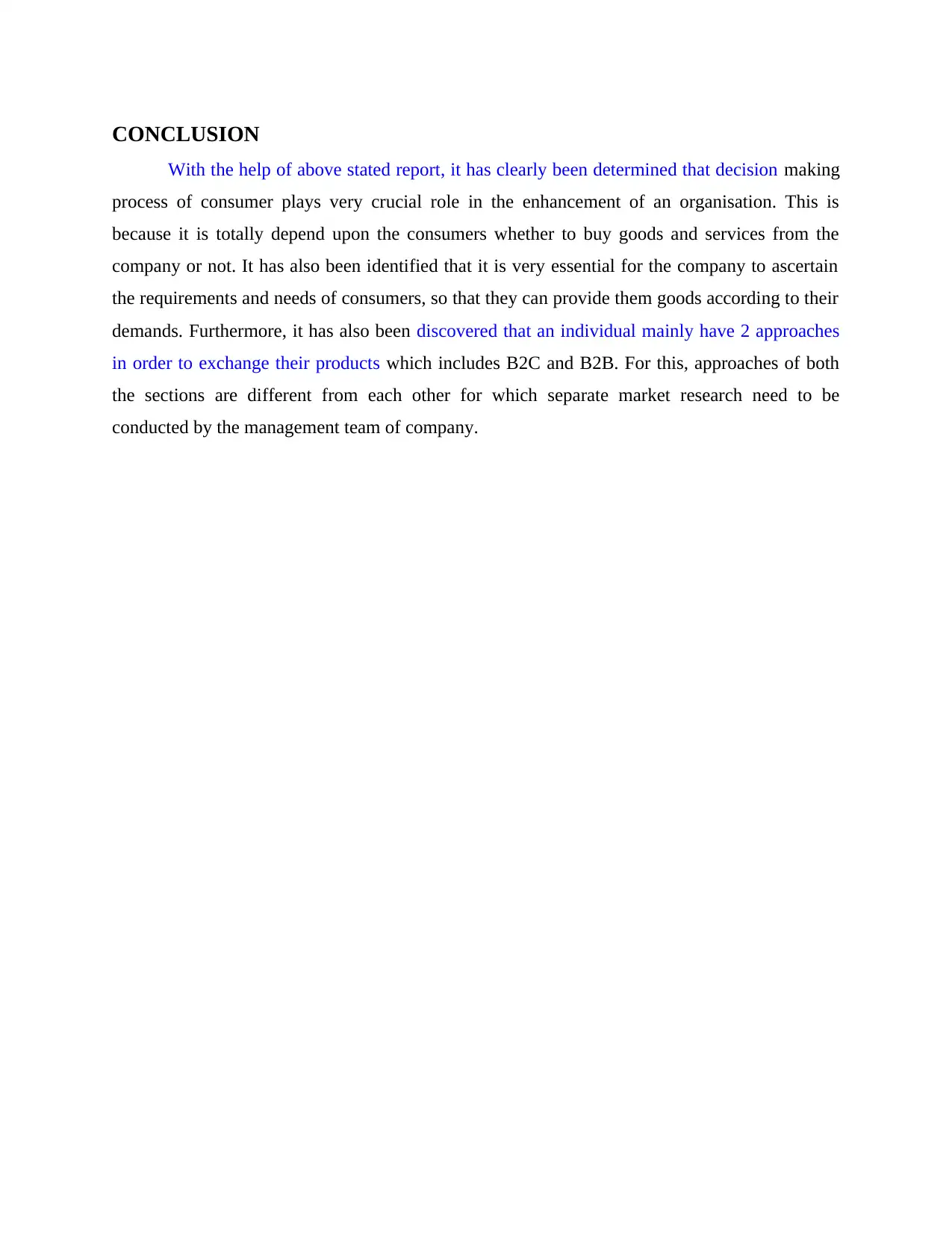
CONCLUSION
With the help of above stated report, it has clearly been determined that decision making
process of consumer plays very crucial role in the enhancement of an organisation. This is
because it is totally depend upon the consumers whether to buy goods and services from the
company or not. It has also been identified that it is very essential for the company to ascertain
the requirements and needs of consumers, so that they can provide them goods according to their
demands. Furthermore, it has also been discovered that an individual mainly have 2 approaches
in order to exchange their products which includes B2C and B2B. For this, approaches of both
the sections are different from each other for which separate market research need to be
conducted by the management team of company.
With the help of above stated report, it has clearly been determined that decision making
process of consumer plays very crucial role in the enhancement of an organisation. This is
because it is totally depend upon the consumers whether to buy goods and services from the
company or not. It has also been identified that it is very essential for the company to ascertain
the requirements and needs of consumers, so that they can provide them goods according to their
demands. Furthermore, it has also been discovered that an individual mainly have 2 approaches
in order to exchange their products which includes B2C and B2B. For this, approaches of both
the sections are different from each other for which separate market research need to be
conducted by the management team of company.
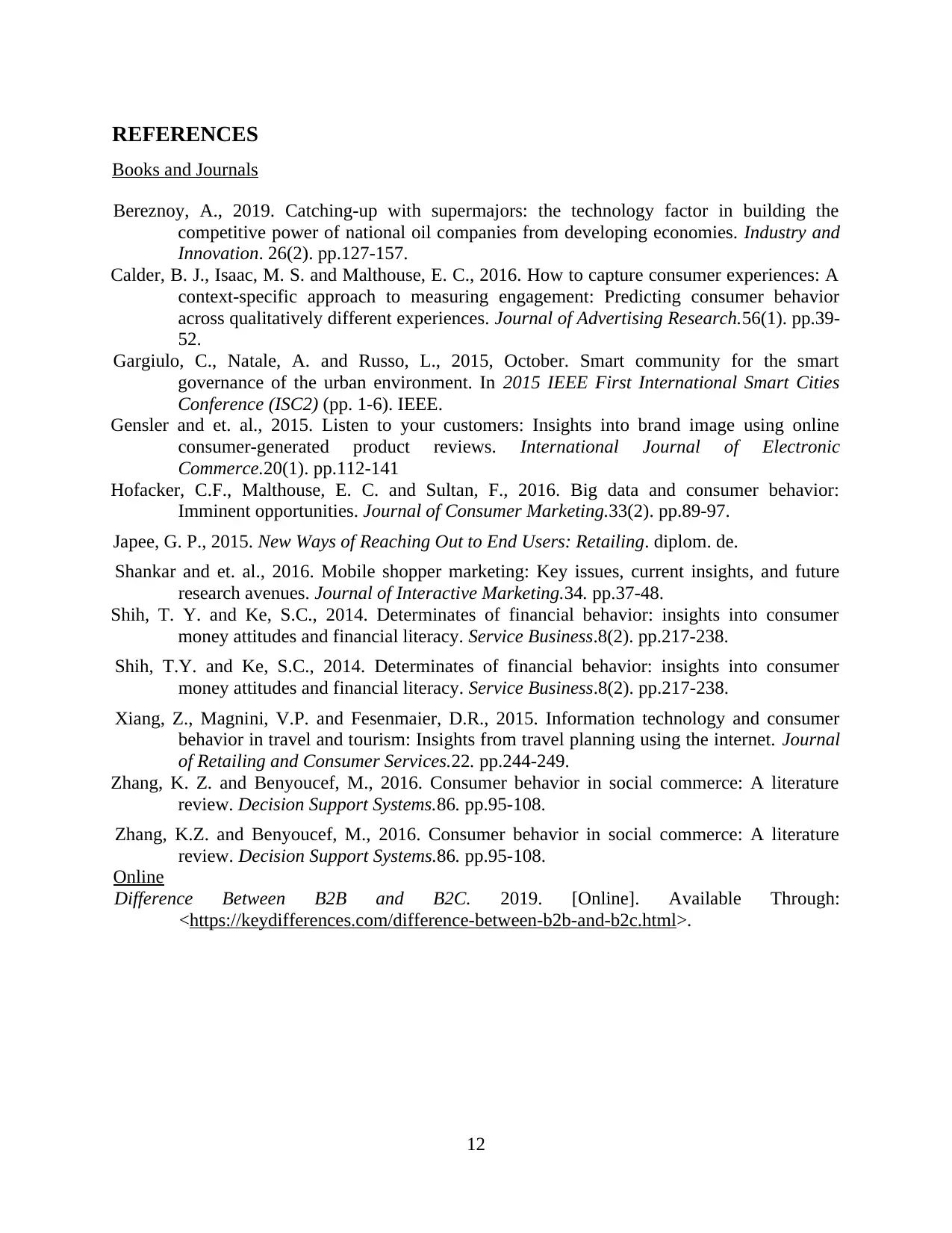
REFERENCES
Books and Journals
Bereznoy, A., 2019. Catching-up with supermajors: the technology factor in building the
competitive power of national oil companies from developing economies. Industry and
Innovation. 26(2). pp.127-157.
Calder, B. J., Isaac, M. S. and Malthouse, E. C., 2016. How to capture consumer experiences: A
context-specific approach to measuring engagement: Predicting consumer behavior
across qualitatively different experiences. Journal of Advertising Research.56(1). pp.39-
52.
Gargiulo, C., Natale, A. and Russo, L., 2015, October. Smart community for the smart
governance of the urban environment. In 2015 IEEE First International Smart Cities
Conference (ISC2) (pp. 1-6). IEEE.
Gensler and et. al., 2015. Listen to your customers: Insights into brand image using online
consumer-generated product reviews. International Journal of Electronic
Commerce.20(1). pp.112-141
Hofacker, C.F., Malthouse, E. C. and Sultan, F., 2016. Big data and consumer behavior:
Imminent opportunities. Journal of Consumer Marketing.33(2). pp.89-97.
Japee, G. P., 2015. New Ways of Reaching Out to End Users: Retailing. diplom. de.
Shankar and et. al., 2016. Mobile shopper marketing: Key issues, current insights, and future
research avenues. Journal of Interactive Marketing.34. pp.37-48.
Shih, T. Y. and Ke, S.C., 2014. Determinates of financial behavior: insights into consumer
money attitudes and financial literacy. Service Business.8(2). pp.217-238.
Shih, T.Y. and Ke, S.C., 2014. Determinates of financial behavior: insights into consumer
money attitudes and financial literacy. Service Business.8(2). pp.217-238.
Xiang, Z., Magnini, V.P. and Fesenmaier, D.R., 2015. Information technology and consumer
behavior in travel and tourism: Insights from travel planning using the internet. Journal
of Retailing and Consumer Services.22. pp.244-249.
Zhang, K. Z. and Benyoucef, M., 2016. Consumer behavior in social commerce: A literature
review. Decision Support Systems.86. pp.95-108.
Zhang, K.Z. and Benyoucef, M., 2016. Consumer behavior in social commerce: A literature
review. Decision Support Systems.86. pp.95-108.
Online
Difference Between B2B and B2C. 2019. [Online]. Available Through:
<https://keydifferences.com/difference-between-b2b-and-b2c.html>.
12
Books and Journals
Bereznoy, A., 2019. Catching-up with supermajors: the technology factor in building the
competitive power of national oil companies from developing economies. Industry and
Innovation. 26(2). pp.127-157.
Calder, B. J., Isaac, M. S. and Malthouse, E. C., 2016. How to capture consumer experiences: A
context-specific approach to measuring engagement: Predicting consumer behavior
across qualitatively different experiences. Journal of Advertising Research.56(1). pp.39-
52.
Gargiulo, C., Natale, A. and Russo, L., 2015, October. Smart community for the smart
governance of the urban environment. In 2015 IEEE First International Smart Cities
Conference (ISC2) (pp. 1-6). IEEE.
Gensler and et. al., 2015. Listen to your customers: Insights into brand image using online
consumer-generated product reviews. International Journal of Electronic
Commerce.20(1). pp.112-141
Hofacker, C.F., Malthouse, E. C. and Sultan, F., 2016. Big data and consumer behavior:
Imminent opportunities. Journal of Consumer Marketing.33(2). pp.89-97.
Japee, G. P., 2015. New Ways of Reaching Out to End Users: Retailing. diplom. de.
Shankar and et. al., 2016. Mobile shopper marketing: Key issues, current insights, and future
research avenues. Journal of Interactive Marketing.34. pp.37-48.
Shih, T. Y. and Ke, S.C., 2014. Determinates of financial behavior: insights into consumer
money attitudes and financial literacy. Service Business.8(2). pp.217-238.
Shih, T.Y. and Ke, S.C., 2014. Determinates of financial behavior: insights into consumer
money attitudes and financial literacy. Service Business.8(2). pp.217-238.
Xiang, Z., Magnini, V.P. and Fesenmaier, D.R., 2015. Information technology and consumer
behavior in travel and tourism: Insights from travel planning using the internet. Journal
of Retailing and Consumer Services.22. pp.244-249.
Zhang, K. Z. and Benyoucef, M., 2016. Consumer behavior in social commerce: A literature
review. Decision Support Systems.86. pp.95-108.
Zhang, K.Z. and Benyoucef, M., 2016. Consumer behavior in social commerce: A literature
review. Decision Support Systems.86. pp.95-108.
Online
Difference Between B2B and B2C. 2019. [Online]. Available Through:
<https://keydifferences.com/difference-between-b2b-and-b2c.html>.
12
⊘ This is a preview!⊘
Do you want full access?
Subscribe today to unlock all pages.

Trusted by 1+ million students worldwide
1 out of 12
Related Documents
Your All-in-One AI-Powered Toolkit for Academic Success.
+13062052269
info@desklib.com
Available 24*7 on WhatsApp / Email
![[object Object]](/_next/static/media/star-bottom.7253800d.svg)
Unlock your academic potential
Copyright © 2020–2025 A2Z Services. All Rights Reserved. Developed and managed by ZUCOL.





